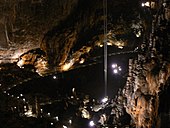Grotta Gigante horizontal pendulum
The Grotta Gigante horizontal pendulums are two horizontal pendulums in the Grotta Gigante near Sgonico in the Friuli Venezia Giulia region . One pendulum is oriented east-west, the other north-south. The two pendulums, which hover independently of each other, sheltered from the wind, in a small building at the bottom of the cave, measure the inclination relative to the vertical, the rotation and the displacement of the rock. They were installed in 1959 by geodesist A. Marussi. The bottom and ceiling points of the pendulums are connected to a staircase running along the cave wall.
description
The pendulum rod is stiff and carries the pendulum mass of 18 kg at one end, at the other end - beyond the center of gravity - the rod is suspended from a 94 m long steel wire attached to the cave ceiling. The excess weight of the pendulum mass is pushed up into the horizontal by a bracing that acts significantly further away from the center of gravity. Due to the torque of the overweight of the pendulum mass, the lower wire is tensioned in general and the upper wire is tensioned in addition to the total weight. Damping elements and wind protection are essential to maintain the high sensitivity to tectonic movements, which is made possible by the particularly long upper suspension.
Each pendulum swings around the virtual axis, through the attachment points of its 2 wires on the ceiling and on the floor of the cave. This axis is slightly inclined to the vertical so that the pendulum mass finds a stable equilibrium position in the respective desired direction. The two wires of a pendulum incline in the opposite direction compared to the axis of rotation, but to different degrees.
The movements detected by the pendulum are aperiodic or periodic , like the earth tides caused by the sun and moon , which deform the globe in a rhythmic manner similar to high tide and ebb.
The earth's crust moves by about 10 cm every 12 or 24 hours due to the tides, which causes the cave to tilt by a few billionths of a radian . On the one hand, observations have contributed to the exploration of the natural vibrations of the earth, and on the other hand, measured the northwest-oriented secular change in inclination of the cave. The sea tides of the Adriatic cause a change in inclination, which gives information about the elastic properties of the earth's crust. The same applies to the tidal wave of the Timavo River , which disappears underground in the Skocjan Cave and touches the Grotta Gigante on its underground course.
The inclinometers are the only instruments that have measured four of the five largest earthquakes in the last 50 years, such as the 1960 Valdivia earthquake (the strongest ever recorded), the 2010 earthquake in Chile , the 2004 Sumatran-Andaman tsunami-generating earthquake , and the Japan earthquake from 2011 , which enables an absolute comparison of these megaquakes. The amplitudes of the natural oscillations of the earth are decisive for these strong earthquakes in order to correctly determine the strength, since earthquake waves only absorb part of the energy of the earthquake.
swell
- Carla Braitenberg ; Ildiko Nagy: Illustrating the superposition of signals recorded by the Grotta Gigante pendulums with musical analogues. In: Acta Carsologica, 43/1, 2014, pp. 139–147
- La stazione geofisica dei pendoli , description of the pendulums on the website of the Grotta Gigante.
Individual evidence
- ↑ https://www.youtube.com/watch?v=q4C7R4MBnIU David Cusanelli: Base Jump - Grotta Gigante, fluido, youtube.com, Video (4:28), June 2, 2013, accessed May 16, 2016. - Base jump near the suspensions.
